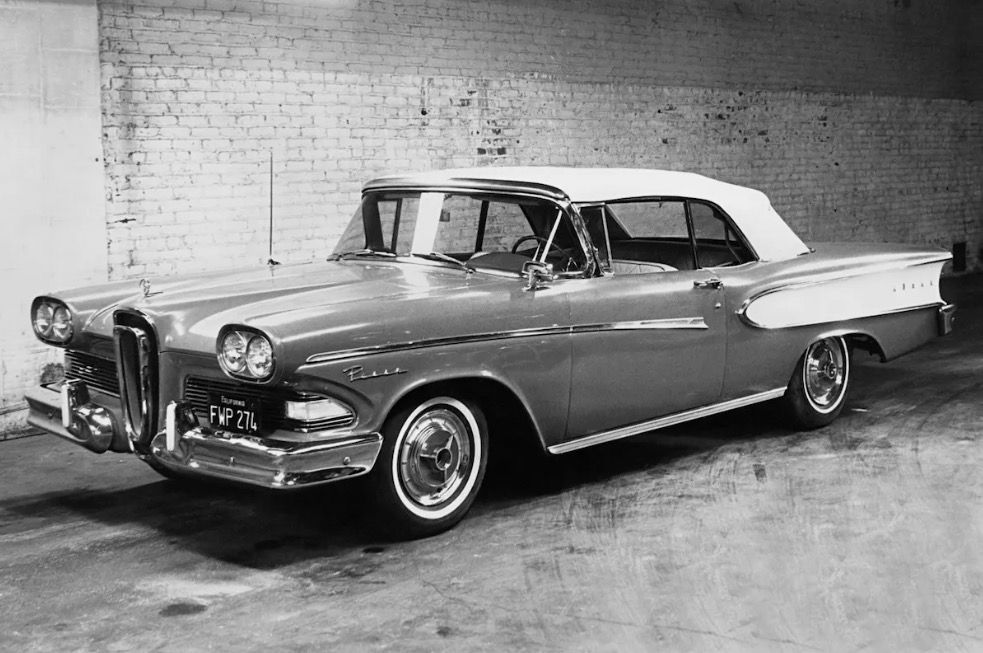These are the top five cars that lost their companies a ton of money. In the high-pressure world of automotive manufacturing, every cent a component can save the company counts. An automotive executive’s success or failure hinges on such razor-thin margins. So, how these five cars were able to lose so much money is actually quite remarkable …
CARS THAT LOST HUGE MONEY
Nevertheless, these five cars demonstrate how even well-funded and carefully planned projects can still go dramatically wrong. They serve as costly reminders that in the automotive world, success requires not just engineering excellence, but precise market timing and accurate consumer insight. Here are the five most costly cars in history, with losses adjusted for inflation …
FORD EDSEL (1958-1960)
As far as wasteful cars go, the Edsel became something of a textbook example of what not to do. Ford Motor Company spent $400 million in the late 1950s (approximately $4 billion in 2024) developing and marketing the Edsel. The company conducted extensive market research, yet somehow created a car that perfectly missed every mark. The Edsel’s infamous vertical grille became a symbol of corporate hubris. And the name became synonymous with commercial failure. Ford pulled the plug after just two years, having produced a mere 118 287 units. However, it was this huge failure that emboldened the Blue Oval to change trajectory and create the Mustang in the 1960s. So, in many ways, we owe the Edsel a great deal of gratitude.
MERCEDES SMART FORTWO (1998-2023)
Never has more money been spent on a compact, affordable car. The Smart project was originally a joint venture between Mercedes-Benz and Swatch. And it demonstrates how even the most prudent cars can be commercial flops. Initial development costs exceeded $1.2 billion, and the project consistently lost money throughout its 25-year run. By 2006 and the end of the gen one, losses had reached approximately $3.7 billion. Despite some clever engineering, innovative design, a ton of marketing and a few redesigns, the ForTwo would never achieve the sales volumes needed to offset its development costs.
VOLKSWAGEN PHAETON (2002-2016)
As luxury cars go, the Phaeton represents the most ambitious overreach in automotive history. And now that we think about it, eerily preempted the dieselgate scandal that was right around the corner. Ferdinand Piech’s dream of an ultra-luxury VW cost the company an estimated $2.7 billion in development and manufacturing. The Phaeton’s revolutionary ‘Transparent Factory’ in Dresden cost nearly $200 million alone to build. The car’s engineering brief was extraordinary, too. Piech wanted it to be capable of driving all day at 300 km/h in 50°C heat while maintaining an interior temperature of 22°C. Despite its technical excellence, consumers simply didn’t want to spend S-Class money on a VW.
BUGATTI VEYRON (2005-2015)
Yes, another one of Ferdinand Piech’s dream cars. The Veyron did successfully restore Bugatti’s reputation as a maker of ultimate performance cars. But it did so at an astronomical cost to the Volkswagen Group. After all the development and engineering costs (it was the fastest car in the world at the time), unfathomably, each Veyron reportedly cost Bugatti around $6.7 million to produce. And yet they only sold for $1.7 million. So, in some ways, it’s the best-value-for-money car ever. With just 450 units built over its production run, the total losses are estimated at $2.25 billion. However, VW Group absorbed the cost and said it’s all in a day’s work to prove its automotive mastery.
DELOREAN DMC-12 (1981-1983)
John DeLorean’s stainless-steel dream car eventually became a cultural icon thanks to Back to the Future, but it was a financial nightmare the carmaker could never emerge from. Even the British government was coerced into investing £100 million (approximately $580 million today) into its troubled Belfast factory. Production eventually ended after just three years and 9 000 cars built. However, the cars were so poorly put together they had to be rebuilt when they emerged from the carrier ships in the United States. Many deals were cancelled, and cars couldn’t be sold. All this extra expense amounted to approximately $1.3 billion in today’s terms. The company’s dramatic collapse, accompanied by DeLorean’s cocaine trafficking trial (though he was eventually acquitted), remains one of the most spectacular cautionary tales in automotive history.
ARE YOU SURPRISED BY THESE BILLION-DOLLAR BLUNDERS?
Let us know by leaving a comment below or send us a WhatsApp on 060 011 0211. Subscribe to The South African’s newsletter and follow us on WhatsApp, Facebook, X and Bluesky for the latest FREE-to-read news.
